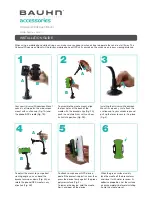
4A. Important Safety Information
87
Imp
o
rt
ant
Saf
e
ty
Inf
o
rmat
io
n
Knowing Radio Frequency Safety
The design of your phone complies with updated NCRP
standards described below.
In 1991–92, the Institute of Electrical and Electronics Engineers
(IEEE) and the American National Standards Institute (ANSI)
joined in updating ANSI’s 1982 standard for safety levels with
respect to human exposure to RF signals. More than 120
scientists, engineers and physicians from universities,
government health agencies and industries developed this
updated standard after reviewing the available body of
research. In 1993, the Federal Communications Commission
(FCC) adopted this updated standard in a regulation. In August
1996, the FCC adopted hybrid standard consisting of the
existing ANSI/IEEE standard and the guidelines published by
the National Council of Radiation Protection and
Measurements (NCRP).
Body-Worn Operation
To maintain compliance with FCC RF exposure guidelines, if
you wear a handset on your body, use a Sprint-supplied or
Sprint-approved carrying case, holster or other body-worn
accessory. If you do not use a body-worn accessory, ensure
the antenna is at least
7/16 inch
(
1.5 centimeters
) from your
body when transmitting. Use of non-Sprint-approved
accessories may violate FCC RF exposure guidelines.
For more information about RF exposure, visit the FCC website
at
www.fcc.gov
.
Specific Absorption Rates (SAR) for Wireless
Phones
The SAR value corresponds to the relative amount of RF
energy absorbed into the head of a user of a wireless handset.
The SAR value of a phone is the result of an extensive testing,
measuring and calculation process. It does not represent how
much RF the phone emits. All phone models are tested at their
highest value in strict laboratory settings. But when in
operation, the SAR of a phone can be substantially less than
the level reported to the FCC. This is because of a variety of
factors including its proximity to a base station antenna, phone
design and other factors. What is important to remember is that
each phone meets strict federal guidelines. Variations in SARs
do not represent a variation in safety.
All phones must meet the federal standard, which incorporates
a substantial margin of safety. As stated above, variations in
SAR values between different model phones do not mean
variations in safety. SAR values at or below the federal standard
of 1.6 W/kg are considered safe for use by the public.
The highest reported SAR values of the MOTOROLA XPRT are:
Cellular CDMA mode (Part 22)
:
Head: 1.03 W/kg; Body-worn: 0.97 W/kg
PCS mode (Part 24)
:
Head: 1.39 W/kg; Body-worn: 1.34 W/kg
Содержание XPRT
Страница 1: ...User Guide ...
Страница 7: ...Section 1 ...
Страница 13: ...Section 2 ...
Страница 44: ... YourPhone s microSD Card page 38 microSD CardSettings page 39 Inserting the microSDCard 2G microSD Card ...
Страница 57: ...Section 3 ...
Страница 87: ...Section 4 ...
Страница 103: ...Index Three Way Calling 56 Transferring Files 39 TTY Use 25 Turning Your Phone On and Off 11 U Updating Your Phone 36 ...











































